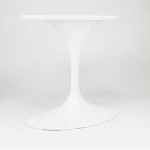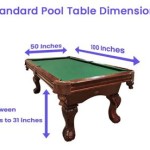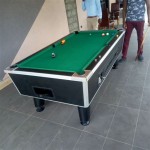What Is The Height Of A Standard Pool Table?
The height of a standard pool table is a critical element in ensuring fair and enjoyable gameplay. This dimension, though seemingly simple, directly influences a player's stance, cueing motion, and overall accuracy. Understanding the standard height specifications and the factors that contribute to its importance is essential for both casual players and serious competitors.
Several organizations govern the regulations and standards for billiard equipment, including the World Pool-Billiard Association (WPA) and the Billiard Congress of America (BCA). These bodies establish guidelines covering various aspects of pool tables, such as the table size, pocket dimensions, cloth type, and notably, the playing surface height. Adherence to these standards facilitates consistent gameplay across different locations and levels of competition.
The specified height for a standard pool table is designed to accommodate the average adult player, providing a comfortable and ergonomic position for striking the cue ball. Deviations from this standard can lead to awkward stances, inconsistent shots, and ultimately, a less enjoyable experience. Consequently, manufacturers adhere to these guidelines when producing pool tables for both commercial and residential use.
Standard Height Specifications
The commonly accepted standard height for a pool table, as defined by both the WPA and the BCA, is between 29 1/4 inches and 31 inches (approximately 74 cm to 79 cm) measured from the floor to the top of the playing surface. This range provides a slight tolerance for manufacturing variations and allows for minor adjustments to suit individual preferences or specific venue requirements. The playing surface refers to the top of the cloth, where the balls roll. It's essential to measure from this point rather than the top of the table's frame, as the frame might add additional height that isn't relevant to gameplay.
This height range has been established based on ergonomic considerations and extensive testing. It allows players of average height to maintain a stable stance, comfortably reach across the table, and execute shots with appropriate cue control. A table that is too low may require players to stoop or bend excessively, leading to back strain and reduced accuracy. Conversely, a table that is too high might necessitate players to reach upwards, compromising their stability and cueing motion.
When selecting a pool table, it's prudent to verify that the height falls within the specified standard range. This ensures that the table is suitable for general play and that it conforms to regulations for sanctioned tournaments. Manufacturers typically provide height specifications in their product descriptions. In cases where customization is possible, confirming adherence to the standard height is crucial for maintaining a consistent and enjoyable playing experience.
Factors Influencing Pool Table Height
While the standard height range is widely recognized, several factors can influence the actual height of a pool table in a particular setting. These factors range from the manufacturing process to environmental conditions and individual adjustments. Understanding these influences can help players and table owners maintain optimal playing conditions.
Manufacturing tolerances inevitably contribute to slight variations in pool table height. Even with precise production methods, minor discrepancies can occur during the assembly process. These variations are generally within the acceptable range defined by the WPA and BCA, but it's important to be aware of their potential impact.
The flooring surface on which a pool table is placed can also affect the perceived height. Uneven floors can cause a table to tilt, resulting in height variations across the playing surface. This is especially relevant in older buildings or rooms with sub-optimal leveling. Careful leveling during installation is crucial for ensuring a consistent and accurate playing experience.
Humidity and temperature changes can also influence the height of a pool table, particularly if the table's components are susceptible to expansion or contraction. Wooden frames and slate beds can be affected by environmental conditions, leading to slight changes in the overall height. Maintaining a stable climate in the room where the pool table is located can minimize these fluctuations.
Furthermore, some pool tables offer adjustable feet or leveling mechanisms. These features allow players to fine-tune the table's height and compensate for uneven flooring. Adjusting the feet can ensure that the playing surface is perfectly level and falls within the standard height range. This is particularly useful for ensuring fair and consistent gameplay.
Impact of Incorrect Height on Gameplay
Deviations from the standard pool table height can significantly impact a player's performance and overall enjoyment. Even a seemingly small difference can alter their stance, cueing motion, and shot accuracy. Recognizing the effects of incorrect height is crucial for addressing potential problems and optimizing the playing experience.
A pool table that is too low can force players to stoop or bend excessively, leading to discomfort and back strain. This posture can restrict their range of motion and compromise their ability to maintain a consistent cueing stroke. Consequently, shots may become erratic and less accurate.
Conversely, a pool table that is too high can necessitate players to reach upwards, compromising their stability and cue control. Reaching can also strain shoulder muscles and reduce the precision of their shots. This can be particularly problematic for shorter players who may struggle to reach certain areas of the table comfortably.
An incorrect pool table height can also affect a player's perspective and depth perception. The altered angle of view can make it difficult to accurately judge distances and angles, leading to miscalculations and missed shots. This can be especially detrimental in games that require precise positioning and strategic planning.
Furthermore, playing on a pool table with an incorrect height can lead to muscle imbalances and repetitive strain injuries over time. The unnatural posture and movements can put undue stress on certain muscle groups, increasing the risk of discomfort and potential long-term health problems. Adhering to the standard height specifications is therefore essential for both performance and physical well-being.

How Tall Is A Standard Pool Table Height Guide Bar 101

How To Measure A Pool Table 4 Dimensions

The Official Size Of A Pool Table Canadian Home Leisure

What Is The Standard Size Of A Pool Table Measurement Guide Room

Room Size Pooltables Com

Pool Table Room Size Calculator

Pool Table Room Size Guide Chart Birkbeck Billiards

What Are Standard Pool Table Dimensions Workout Hq

Pool Table Height Google Search Professional Dimensions

What Size Room Will I Need For My Snooker Table Liberty








